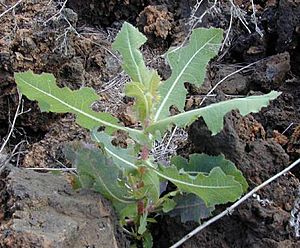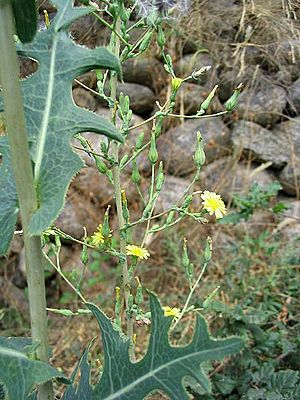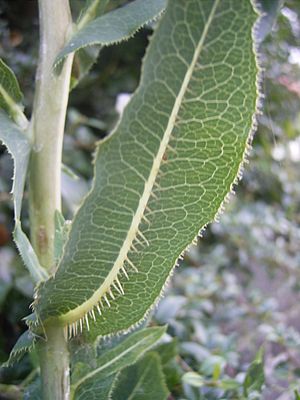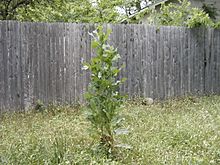Prickly lettuce facts for kids
Quick facts for kids Prickly lettuce |
|
|---|---|
 |
|
| Scientific classification | |
| Genus: |
Lactuca
|
| Species: |
serriola
|
| Synonyms | |
|
Synonymy
Lactuca altaica Fisch. & C.A.Mey.
Lactuca augustana All. Lactuca coriacea Sch.Bip. Lactuca dubia Jord. Lactuca integrata (Gren. & Godr.) A.Nelson Lactuca latifolia Boiss. Lactuca latifolia Gilib. Lactuca scariola L. Lactuca sylvestris Lam. Lactuca tephrocarpa K.Koch Lactuca verticalis Gaterau |
|
Lactuca serriola, also called prickly lettuce, milk thistle (not to be confused with Silybum marianum, also called milk thistle), compass plant, and scarole, is an annual or biennial plant in the tribe Cichorieae within the family Asteraceae. It has a slightly fetid odor and is commonly considered a weed of orchards, roadsides and field crops. It is the closest wild relative of cultivated lettuce (Lactuca sativa L.).
Lactuca serriola is known as the compass plant because in the sun the upper leaves twist round to hold their margins upright.
Lactuca serriola is native to Europe, Asia, and north Africa, and has become naturalized elsewhere.
Description
Lactuca serriola has a spineless reddish stem, containing a milky latex, growing up to 2 metres (6 ft 7 in).
The leaves get progressively smaller as they reach its top. They are oblong or lanceolate, often pinnately lobed and (especially for the lower leaves), waxy grey green. Fine spines are present along the veins and leaf edges. The undersides have whitish veins. They emit latex when cut.
The flower heads are 1–1.5 cm (1⁄2–1⁄2 in) wide, pale yellow, often tinged purple, with 12–20 ray flowers but no disc flowers. The bracts are also often tinged purple. It flowers from July until September in the northern hemisphere. The achenes are grey, tipped with bristles. The pappus is white with equal length hairs.
Similar to Mycelis muralis but showing more than 5 florets.
It can cause pulmonary emphysema in cattle feeding exclusively on the plant.
Culinary and medicinal uses
Lactuca serriola can be eaten as a salad, although it has something of a bitter taste. Young leaves can be eaten raw or cooked. Older leaves can be steamed. While unsubstantial, its roots have been used as a coffee substitute.
The Ancient Greeks believed its pungent juice to be a remedy against eye ulcers. Following its accidental introduction to North America, the Navajo began to use the plant as a ceremonial emetic. In the island of Crete in Greece the leaves and the tender shoots of a variety called maroula (μαρούλα) or agriomaroulo (αγριομάρουλο) are eaten boiled. It is used by a growing number of Jews and Samaritans as the Maror (bitter herb) on Pesach.
Lactuca serriola contains lactucarium, which is the milky sap (white latex) that flows through the stem of the plant. It is used as a medicinal herb when dried after contact with air. Although the standard definition of lactucarium requires its production from Lactuca virosa, it was recognized that smaller quantities of lactucarium could be produced in a similar way from Lactuca sativa and Lactuca canadensis var. elongata.
History
The Egyptian god Min is associated with this species of lettuce. Also, archaeobotanical evidence in Greek archaeological contexts is scanty, although uncarbonised seeds have been retrieved from a 7th-century BC deposit in a sanctuary of Hera on Samos. It is also described by Theophrastus. In mythology, Aphrodite is said to have laid Adonis in a lettuce bed, leading to the vegetable's association with food for the dead.
See also
 In Spanish: Lactuca serriola para niños
In Spanish: Lactuca serriola para niños




